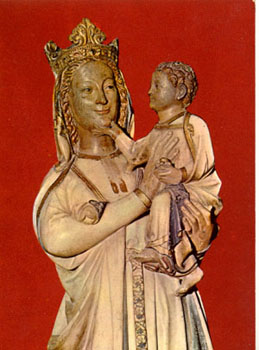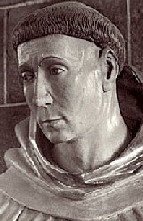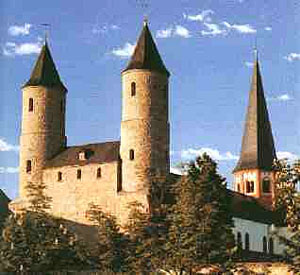 |
The Saint of the Day
St. Herman Joseph, April 7
Prof. Plinio Corrêa de Oliveira
Biographical selection:

Throughout his life, St. Herman Joseph enjoyed a great familiarity with Our Lady
|
St. Herman was a great devotee of Our Lady and one of the most popular of medieval contemplatives. He was born in Cologne, Germany in 1150 into a family of good name that had lost its wealth. From his early childhood he sought out the altar of the Holy Virgin to converse with her. His simplicity was charming.
On one occasion he brought an apple to the Mother of God and asked her to accept it. The statue of the Virgin moved, and she extended her hand to take the gift.
Another time he arrived at the church and saw the Queen of Heaven in great splendor in the choir. At her side were two children, St. John the Baptist and the Christ Child playing together. As Herman stood contemplating the scene, the Virgin called to him. He swiftly climbed the steps of presbytery, but the grilled gate to the choir was closed and locked.
“I cannot reach you,” he said to Mary, “the grill is locked and there is no ladder for me to climb over it.”
The Holy Virgin then directed him where to put his hands and feet in order to climb over the grill. Doing this, he entered the choir and she told him to join the Christ Child and St. John in play.

St. Herman Joseph
|
One cold winter day he came barefoot to the church to pray. As he approached the statue of Our Lady, she asked him: “Why are you barefoot on this cold day?”
He answered: “Because I don’t have shoes.” She told him to look under a certain stone in the church where he would find enough money for a pair of shoes.
The whole life of St. Herman was filled with visions and ecstasies. Until his last day he enjoyed a continuous familiarity with the supernatural.
At age 12 Herman joined the Premonstratensians (Norbertines) of Steinfeld, where he was assigned many different jobs. Later, he was ordained a priest, and became the director of several convents of sisters, for whom he wrote various treatises on piety and a commentary on the Canticle of Canticles. He also composed hymns, one being the first hymn in honor of the Sacred Heart of Jesus.

The Steinfield monastery dating from the 11th century
|
His life was one of continuous penance, and he suffered strong temptations and physical illnesses. He was afflicted by incessant headaches that only ceased when he approached the altar to celebrate Mass. Their violence used to increase with the approach of Feast Days. In a play on words, he used to say: Festa sunt mihi infesta [the Feast Days are devastating for me].
He had great sympathy for afflicted persons who always found in him a warm welcome and secure refuge.
He died in 1241, after having added the name Joseph to his first name under the personal guidance of Our Lady. Later his body was found incorrupt.
Comments of Prof. Plinio:

The life of St. Herman is like a drop of Heaven on earth
|
The life of St. Herman was like a drop of Heaven on earth, and hearing it gives us nostalgia for Heaven. The marvelous atmosphere that accompanies it by contrast permits us to see how dirty, deformed, aggressive and chaotic the atmosphere of the Revolution is in which we are immersed today.
For us this description has an effect similar to that of an angel who would visit Purgatory and bring a breath of fresh air to the souls suffering in its flames. Considering his life, we can say: The day will come when I also will go to Heaven, and I will no longer have to see and live among all these monstrosities of the Revolution. I will see St. Herman and I will be able to talk with him. It is a drop of the hope for Heaven amid the terrible furnace of our days.


  | | Prof. Plinio Corrêa de Oliveira | |
The Saint of the Day features highlights from the lives of saints based on comments made by the late Prof. Plinio Corrêa de Oliveira. Following the example of St. John Bosco who used to make similar talks for the boys of his College, each evening it was Prof. Plinio’s custom to make a short commentary on the lives of the next day’s saint in a meeting for youth in order to encourage them in the practice of virtue and love for the Catholic Church. TIA thought that its readers could profit from these valuable commentaries.
The texts of both the biographical data and the comments come from personal notes taken by Atila S. Guimarães from 1964 to 1995. Given the fact that the source is a personal notebook, it is possible that at times the biographic notes transcribed here will not rigorously follow the original text read by Prof. Plinio. The commentaries have also been adapted and translated for TIA’s site.
|
Saint of the Day | Home | Books | CDs | Search | Contact Us | Donate

© 2002- Tradition in Action, Inc. All Rights Reserved
|
 |

|